

This site uses non-intrusive cookies to enable us to provide a better user experience for our visitors. No personal information is collected or stored from these cookies. The Society's policy is fully explained here. By continuing to use this site you are agreeing to the use of cookies.
[as described in the July 1914 edition of the Railway Magazine.]
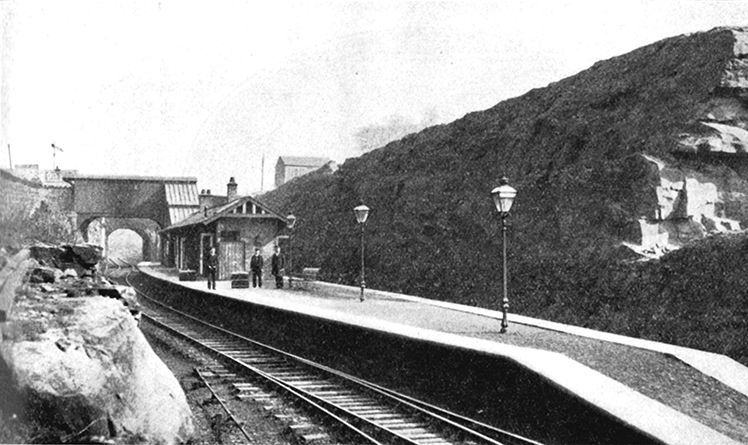
[Arthur Shaw Seacombe.] Lisard And Poulton Station.
ALTHOUGH the London and North Western and Great Western Joint line from Chester to Birkenhead is quite an old-established institution, it is .only in recent years, comparatively speaking, that the Wirral Peninsula has been given adequate railway communication with the surrounding districts. Now, of course, there are many lines in this region-the Chester and Birkenhead, with the branch from Hooton to West Kirby; the Great Central (formerly Liverpool and North Wales Railway) from Bidston to Connah's Quay, Chester and Wrexham; and the Mersey Railway, which owns the famous tunnel and leads to Rock Ferry on the one hand and Birkenhead Park on the other, connecting with the joint railways at the former place and with the subject of this article at the latter. The Wirral Railway fills up the gap left by the above-mentioned lines: it runs from Birkenhead Park station and from Seacombe (adjacent to the pier, used by the Mersey ferry steamers) to New Brighton and West Kirby. The line opens up a splendid suburban district, besides providing an all-rail route to New Brighton, beloved of pleasure-seekers.
Beauty spots in South Lancashire are not unlimited in number, and the more popular of them have during recent years become rather densely populated. Consequently, the business people of Liverpool cast their eyes " across the water," as the saying goes, and the movement to the Wirral district has become so large a factor that "the other side" is now sometimes referred to as "The dormitory of Liverpool," owing to the number of people who reside on the Cheshire side of the Mersey and travel across or under the water daily to and from business.
Until the Wirral Railway was opened access to Liverpool from West Kirby was over the joint railway companies' lines viii Hooton, a somewhat indirect route. Nowadays, West Kirby is easily and quickly reached by the direct line of the Wirral Railway, either from Sea combe or by means of the Mersey Railway. This latter line, since its electrification, affords a quick and comfortable route to the other side of the river, its great advantage being independence of the weather. Fogs are sometimes so bad on the Mersey during the winter months that the ferry service is somewhat interfered with. However, notwithstanding climatic conditions, or perhaps because of the wonderfully smart working of the Mersey ferry steamers, the route to places in the Wirral via Seacombe Pier is very popular.
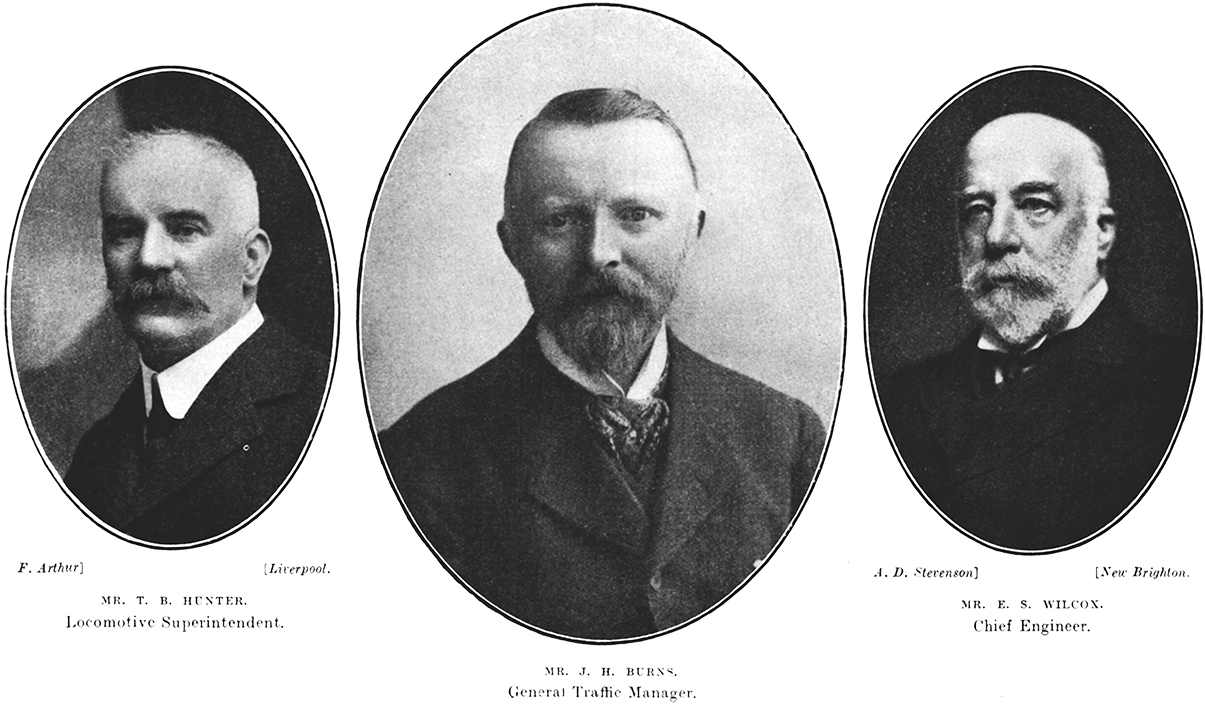
Places of interest on the Wirral Railway are numerous. The commercial interest, though not prominent (the Wirral is pre-eminently a passenger line), is seen at the Birkenhead end of the line, where there is communication with the lines of the Mersey Docks and Harbour Board.
Commencing a journey at Seacombe, we pass these junctions and the western end of the "Great Float," upon which are situated the magnificent Birkenhead Docks. Passing through Liscard and Poulton, the wooded slopes of Bidston Hill appear, as also does the somewhat maigre Bidston station. On the summit of the hill is the Northern Observatory, and it is said that the telescope through which the Transit of Venus was first observed is preserved in the building. Leasowe Castle, sometimes called " Mockbeggar Hall," next claims attention, It was built in 1593 by Ferdinando, Earl of Derby, and in the sixteenth century was a place of importance; a race course was laid out near by upon which the first" Derby" took place. Indeed, the Wallasey Stakes are still in the bill at Epsom. To-day the buildings are 'in the hands of the Trustees of the Railwaymen's Convalescent Homes, a most excellent and well-managed institution, also maintaining the older "Home" at Herne Bay in Kent. The antiquary may find in the vicinity a submarine forest, and, which is of more consequence to the majority, the beach is excellent for bathing; this last, indeed, is common to most places on the Wirral Railway.
We next come to Moreton and Meols, growing town lets on a coast which is famous for its" winds that blow from the south," or rather, south-west, which winds are predominant for ten out of the twelve months. The railway now takes a south-westerly direction, and brings us to Hoylake. Here the Deeside shores may be said to begin, and here may be witnessed the wonderful Turneresque sunsets for which the locality is famous. Hoylake may also be called the mother home of the "royal and ancient game of golf," and within its demesne are situated the links of the Royal Liverpool Golf Club. Nor are archaeological interests wanting. Accessible at low water is the Island of Hilbre, mentioned in Domesday Book and site of a monastery founded in one of his better moments by King John. In the 16th and 17th centuries Hoylake was an important port, the bulk of the trade between England and Ireland being carried on there. It was the point of William the Third's departure for the Emerald Isle in 1690.
West Kirby, which is theultima thule of the Wirral Railway, is round the corner, and overlooks the extensive Sands of Dee, where Mary in the old song went "to call the cattle home." Owing to its situation and to the ozone from the aforesaid sands, West Kirby is one of the most beneficial spots in England for anyone needing the open air cure. It is a cheerful little town with plenty going on, while the view from the hills behind the town is a treat for the jaded town-dweller, embracing as it does the Bay of Liverpool and the Dee Estuary, while the mountains of North Wales form a striking background.
The other section of the Wirral Railway is shorter but equally important. Leaving the West Kirby line before we come to Bidston station, the train heads northwards and enters the district of Wallasey, which is served by two stations. This" ancient village" of the old chronicles has a splendid shore on the open Irish Sea, and is a favourite residential place. Turning in an easterly direction and running along the picturesque littoral, New Brighton is reached. This place, which is known all over the world as a pleasure resort, and is a favourite suburb of the Liverpolitans, almost rivals Blackpool in its lavish provision of entertainments, while not the least of its charms is the ever varying panorama of the sea-borne traffic of Liverpool. From the Mersey frontage we may see such famous leviathans as the Mauretania and Aquitania. to mention only two among many, while the Ben-my-Chree, of the Isle of Man Steam Packet Company, and the Liverpool and North Wales steamer, the famous La Marguerite are also features of interest. And yet the place is not at all spoilt in spite of the millions of trippers who visit it; fine houses with well-kept gardens grace the promenade, while the resident has choice of either sea or river view.
The history of the Wirral Railway goes back to 1863, when the Hoylake Railway Company was incorporated, with powers to make railways from Birkenhead and Poulton to Hoylake. In 1865 further extensions were authorised, to New Brighton and Parkgate, but the full powers were not then exercised. Changes took place a few years later, in 1872, when the Hoylake and Birkenhead Rail and Tramways Company was founded to acquire the lines of the Hoylake Company. In the following year, 1873, powers were obtained to make an extension to West Kirby, and to make a short line at the Birkenhead end connecting the Dock lines of the Mersey Dock and Harbour Board.
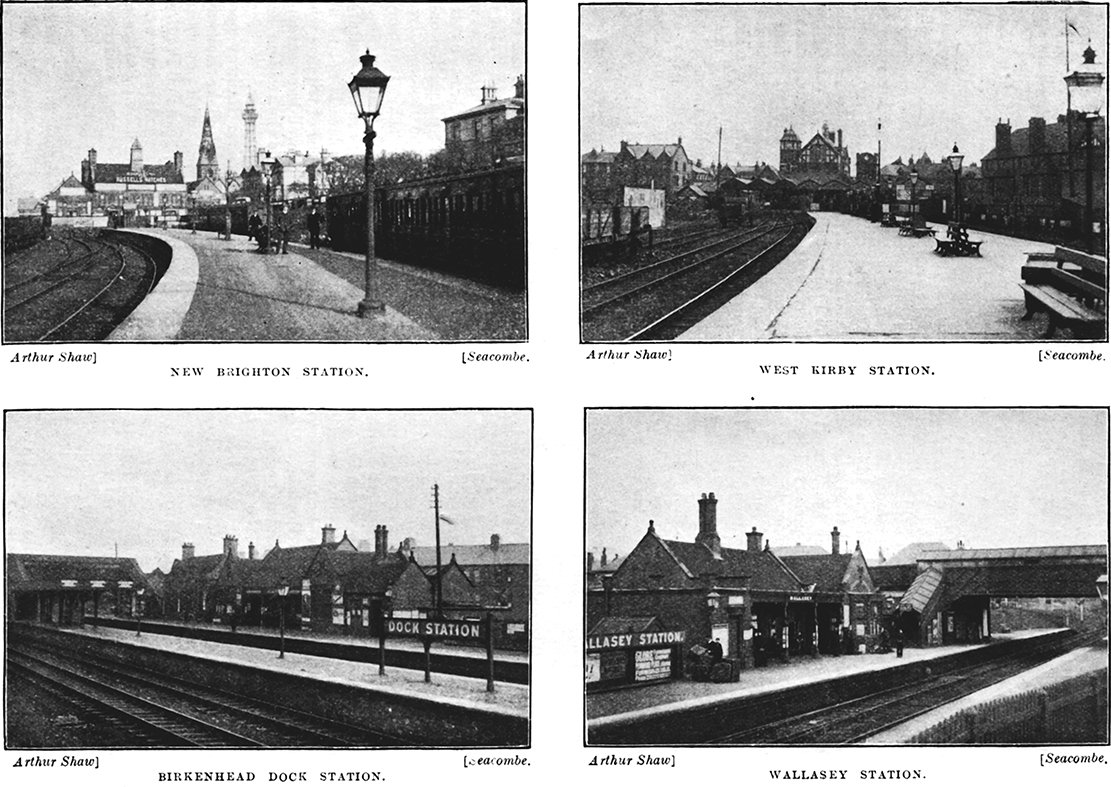
In 1881, powers were obtained to change the name of the Company to the Seacombe, Hoylake and Deeside Railway Company, and to make an extension to Seacombe. The latter powers were not, however, exercised until some years later, the extension to Seacombe being opened in 1895. The terminus, since re-named Seacombe and Egremont, is situated close to the ferry to Liverpool. A further extension from Wallasey to New Brighton was opened in 1888,
The Wirral Railway Company was incorporated in 1883, and by the Acts of 1884, 1885 and 1888 was authorised to construct railways in the county of Chester connecting with the Great Central near Connah's Quay; the existing Seacombe, Hoylake and Deeside Railways, and the Mersey Railway.
The partially completed line from Bidston to Connah's Quay was, by the Act of 1889, transferred to the joint ownership of the Great Central and Wirral, Mersey and Connah's Quay Railways. The connection with the Mersey Tunnel Railway at Birkenhead Park station was opened in 1888. In 1891 the various undertakings were amalgamated under the name of the Wirral Railway Company.
As mentioned before, there are two routes from Liverpool to the Wirral stations. The Seacombe ferry steamer from the landing stage at Liverpool connects with the West Kirby service, the journey, including the change from boat to train, taking only 33 minutes. Seacombe station is also the place of departure for Great Central trains to Chester and Wrexham. The other route, via the Mersey Railway and Birkenhead Park, serves both sections of the Wirral Railway, the electric trains of the former conveying the passenger through the great tunnel, now happily free from mephitic vapours. By this route West Kirby is 28 minutes from Liverpool, the journey to New Brighton taking 21 minutes.
The Wirral Railway derives the bulk of its revenue from passengers, the amount received from goods being only a fifth of that from passenger traffic, albeit there are important goods connections at Birkenhead Docks. With, however, a short mileage, fourteen miles in all, and that mainly to rising residential places, it is not surprising that this should be the case.
Coming to the equipment of the line, we find a high standard of maintenance. All of the mileage is double track and laid with bull-head rails 30 ft. long, weighing 85 lbs. to the yard. The stations, as may be seen from the illustrations, are neat and adequate, with the exception of Bidston, the dominant colour being a pleasing shade of green. New Brighton, Hoylake and West Kirby are particularly good, especially the last mentioned.
As might be expected from the nature of the country, the uphill work demanded of the engines is not of a serious character. There are, however, a few banks, Liscard being the summit on the Seacombe line, with rises at 1 in 100 and 1 in 150 from that place and 1 in 100 and 1 in 125 on the other side. The approach to New Brighton is a two-mile rise mainly at 1 in 100, terminating with 1 in 88. The West Kirby line is gently undulating and calls for no special effort, except on Bank Holidays, when the train loads provide problems for the engines to solve on all the routes.
The locomotive stud ,consists of fifteen tank engines, there being six different types, Although there are no tender locomotives, some very interesting examples of construction may be seen. For the goods traffic powerful 0-6-4 engines are employed, with 5 ft. 3 in. driving wheels and 18 in. by 26 in. cylinders; they weigh 62 tons. There is a little 2-4-0 and one of the 4-4-2 type. The Wirral possesses three engines of the interesting and uncommon 4-4-4 wheel arrangement; these are fine machines with a large reserve of power, while their extensive bunker and tank capacity enables them to work long turns when required. These have driving wheels 5 ft. 2 in. diameter, 17 in. by 24 in. cylinders, and a weight of 59¾ tons. The most numerous class of engine on the line is the popular 0-4-4 tank, over half the stock being of this type. A considerably enlarged edition bas just been added in the shape of No.3. This smart engine is a great favourite both with her designer and driver, and the class will probably be added to in the near future. No.3 has 5 ft. 6 in. driving wheels, cylinders 18 in. by 26 in., and weighs in working order 541 tons; she is the only engine on the line with a Belpaire firebox, and carries 2,000 gallons of water and 3 tons of coal. One engine remains to be mentioned, No.4, formerly the property of the London and North Western Railway. As this machine, of the familiar double-ender type with 4 ft. 6 in. driving wheels, is so well-known, mention will suffice without description. But it is an interesting change of ownership. All the Wirral locomotives, with the exception of No.4, have been built by Messrs. Beyer, Peacock & Co., of Manchester.
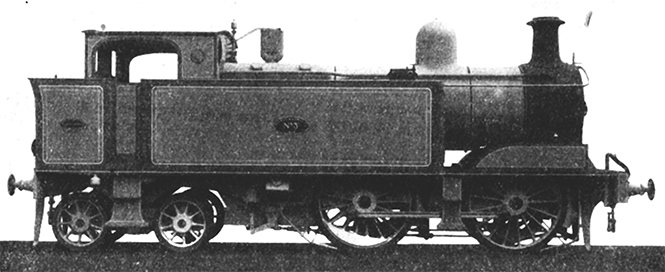
New 0-4-4 Tank Engine, Recently. Placed In Service.
Turning to the carriage department, we find that the Wirral has taken the lead in one very useful improvement of stock-the mounting of two old coach bodies on a long underframe carried on bogies. It will be remembered that the London, Brighton- and South Coast Railway has done a great deal of this kind of work with very beneficial results to the comfort of the passenger. It is, of course, obvious that there are many cases where the body of a four or six-wheel coach differs in no respect from the body of a bogie vehicle belonging to the same company. Of course, in the case of a small line like the Wirral heavy mechanical construction is. not undertaken. The underframes for these re-builds came from the Consett Iron Company, and the bogies from Messrs. Pickering. The body work, or what might be called the cabinet-maker's work, is done by the Wirral Company's own men at Hoylake, as also is the painting. The underpart of the coach and the metal work is dealt. with at the shops adjacent to Birkenhead Docks station, and the coach is completed at Hoylake. There are several varieties of eight-wheel coaches on the line, from 54 ft. to 59 ft. in length and varying a little in their internal arrangements. There are eight-bodied firsts, coaches with four firsts and four thirds, others with five firsts and four thirds, and some excellent brake thirds having five or seven compartments. There is also a very fine bogie brake composite with two first saloon compartments, one third saloon, one third-class compartment and a brake. The firsts are most artistically decorated, and the whole coach reflects great credit on the Brush Electrical Company, who are the makers. All the above-mentioned stock rides perfectly and compares favourably in this respect with any in England.
The remainder of the passenger stock is composed of four and six-wheel coaches of the usual type, but with fittings corresponding to . the bogie stock; and all in thoroughly good. condition. The bulk of the stock has been purchased from the Midland and Mersey Railways, and serves its purpose very well after renovation. Incandescent gas is the illuminant, and the coaches are painted a rich shade of chocolate. The goods rolling stock is of the ordinary type, and is. adequate to the needs of the traffic. The engines are painted. black and somewhat resemble in finish the locomotives built at Crewe Works.
As we have seen before, the Wirral has important connections with its neighbours. Passenger traffic is exchanged with the Great Western and London and North Western Joint Railway at West Kirby, where there is also a physical connection which is useful for goods traffic. With the Great Central's Wrexham and Chester line the Wirral has close connection, the' trains of the former company using the latter's line from Bidston to Seacombe. Trains run in connection with this service and provide Liverpool with an alternate rail access to North Wales. But it is with the Mersey Tunnel Railway that the Wirral has most intimate relations. By means of close connections at Birkenhead Park, the Wallasey and West Kirby districts are brought very close to Liverpool. There is a change of train at Park station, but as there is no change of platform the inconvenience is but slight.
This last point brings to our notice the fact that the Wirral has powers to electrify its line. The matter is one for financial experts, but from "information received" it would not be a great surprise to the railway world if this took place within the next decade. When this electrification becomes an established fact it will be possible to have through trains from the Wirral country right into Liverpool over the Mersey Railway. The idea is well within the region of practical politics, for the district is developing by leaps and bounds, and facilities in the shape of increased train services will be demanded to such an extent that electrification will be the only solution of the traffic problem.
An account of the Wirral Railway would be incomplete without mention of the able and energetic Traffic Manager, Mr. J. H. Burns. What Mr. Burns has done for the line is better expressed by reviewing the vast improvements which have taken place under his regime. With Mr, Burns' name we may couple those of Mr. T. B. Hunter, the Locomotive Superintendent, and Mr. E. S. Wilcox, the Engineer. We may safely say that the fortunes of the Wirral Railway are in good hands under these three gentlemen, aided as they are by an energetic and courteous staff.
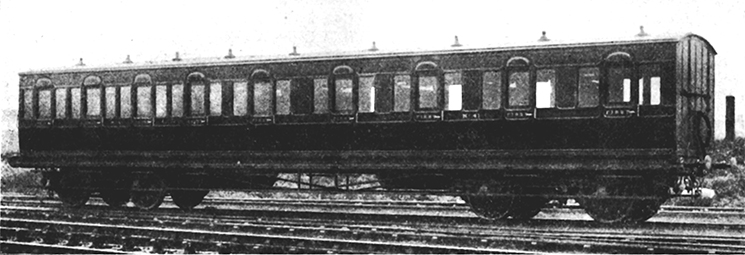
[Photo: Locomotive Publishing Co. Ltd.] Remodelled First And Third Composite Carriage.
Site contents Copyright © LMS Society, 2026
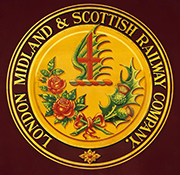
January 1st, 2026
Site contents Copyright © LMS Society, 2026